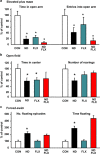Antidepressant responsiveness in adulthood is permanently impaired after neonatal destruction of the neurogenic pool
- PMID: 28045461
- PMCID: PMC5545723
- DOI: 10.1038/tp.2016.255
Antidepressant responsiveness in adulthood is permanently impaired after neonatal destruction of the neurogenic pool
Abstract
The dynamic turnover of hippocampal neurons is implicated in the regulation of cognitive and affective behavior. Extending our previous demonstration that administration of dexamethasone (ND) to neonatal rats depletes the resident population of neural precursor cells (NPC) and restrains the size of the neurogenic regions, we now show that the adverse effects of ND persist into adulthood. Specifically, ND impairs repletion of the neurogenic pool and neurogenesis; ND also compromises cognitive performance, the ability to actively adapt to an acute stressor and, the efficacy of glucocorticoid (GC) negative feedback. Interestingly, although ND depletes the neurogenic pool, it does not permanently abolish the proliferative machinery of the residual NPC population; however, ND increases the susceptibility of hippocampal granule neurons to apoptosis. Although the antidepressant fluoxetine (FLX) reverses the latter phenomenon, it does not replenish the NPC pool. Treatment of ND-treated adult rats with FLX also improves GC negative feedback, albeit without rescuing the deleterious effects of ND on behavior. In summary, ND leads to protracted disruption of mental functions, some of which are resistant to antidepressant interventions. We conclude that manipulation of the NPC pool during early life may jeopardize the therapeutic potential of antidepressants in adulthood.
Conflict of interest statement
The authors declare no conflict of interest.
Figures





Similar articles
-
Depletion of the neural precursor cell pool by glucocorticoids.Ann Neurol. 2010 Jan;67(1):21-30. doi: 10.1002/ana.21812. Ann Neurol. 2010. PMID: 20186952
-
Influence of enrichment on behavioral and neurogenic effects of antidepressants in Wistar rats submitted to repeated forced swim test.Prog Neuropsychopharmacol Biol Psychiatry. 2015 Apr 3;58:15-21. doi: 10.1016/j.pnpbp.2014.10.017. Epub 2014 Dec 6. Prog Neuropsychopharmacol Biol Psychiatry. 2015. PMID: 25485962
-
Protein kinase Mζ is involved in the modulatory effect of fluoxetine on hippocampal neurogenesis in vitro.Int J Neuropsychopharmacol. 2014 Sep;17(9):1429-41. doi: 10.1017/S1461145714000364. Epub 2014 Mar 28. Int J Neuropsychopharmacol. 2014. PMID: 24679950
-
A ventral view on antidepressant action: roles for adult hippocampal neurogenesis along the dorsoventral axis.Trends Pharmacol Sci. 2014 Dec;35(12):675-87. doi: 10.1016/j.tips.2014.09.011. Epub 2014 Oct 23. Trends Pharmacol Sci. 2014. PMID: 25455365 Review.
-
Research update: neurogenesis in adult brain and neuropsychiatric disorders.Mt Sinai J Med. 2006 Nov;73(7):931-40. Mt Sinai J Med. 2006. PMID: 17195878 Review.
Cited by
-
Prenatal psychological stress mediates vertical transmission of gut microbiome to the next generation affecting offspring depressive-like behaviors and neurotransmitter.BMC Psychol. 2025 Jul 15;13(1):791. doi: 10.1186/s40359-025-03088-y. BMC Psychol. 2025. PMID: 40665363 Free PMC article.
-
Ablation of proliferating neural stem cells during early life is sufficient to reduce adult hippocampal neurogenesis.Hippocampus. 2018 Aug;28(8):586-601. doi: 10.1002/hipo.22962. Hippocampus. 2018. PMID: 29742815 Free PMC article.
References
-
- Shors TJ. From stem cells to grandmother cells: how neurogenesis relates to learning and memory. Cell Stem Cell 2008; 3: 253–258. - PubMed
-
- Sousa N, Almeida OFX. Disconnection and reconnection: the morphological basis of (mal)adaptation to stress. Trends Neurosci 2012; 35: 742–751. - PubMed
-
- Zhao C, Deng W, Gage FH. Mechanisms and functional implications of adult neurogenesis. Cell 2008; 132: 645–660. - PubMed
Publication types
MeSH terms
Substances
LinkOut - more resources
Full Text Sources
Other Literature Sources
Medical
Miscellaneous

